
State of Stress
Uniaxial Stress State
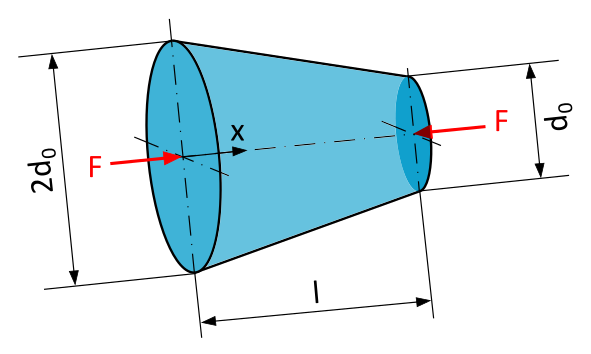
Conical Rod and Compressive Force
A conical rod with a circular cross-section and length \(l=250~\mathrm{mm}\) is loaded, as shown in Figure 1, by a compressive force \(F=10~\mathrm{kN}\) along the axis of the rod. The diameter at \(x=0\) is twice as large as the diameter at \(x=l\) with \(2d_0=150~\mathrm{mm}\) and \(d_0=75~\mathrm{mm}\), respectively.
- What is the formula for calculating the normal stress \(\sigma\) at any location x in a section perpendicular to the axis of the rod?
- What is the magnitude of the normal stress \(\sigma\) at the location \(x=200~\mathrm{mm}\) in a section perpendicular to the axis of the rod?
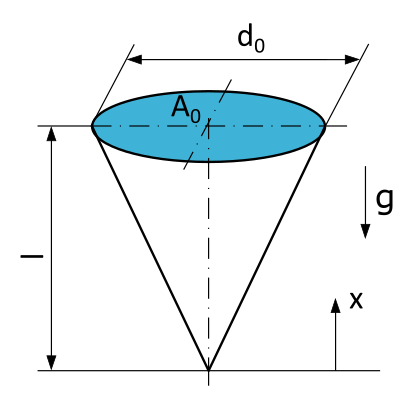
Suspended Cone
An icicle is hanging from a gutter. The icicle has the shape of a circular cone with a length \(l=10~\mathrm{cm}\), a diameter \(d_0=5~\mathrm{cm}\) at the suspension point, and a cross-sectional area \(A_0\). The ice has a density of \(\varrho = 0,91~\mathrm{g/cm^3}\).
- What is the formula for calculating the normal force \(N\) at any location x in a section perpendicular to the axis of the cone?
- What is the formula for calculating the normal stress \(\sigma\) at any location x in a section perpendicular to the axis of the cone?
- What is the magnitude of the normal stress \(\sigma\) at the location \(x=70~\mathrm{mm}\) in a section perpendicular to the axis of the cone?
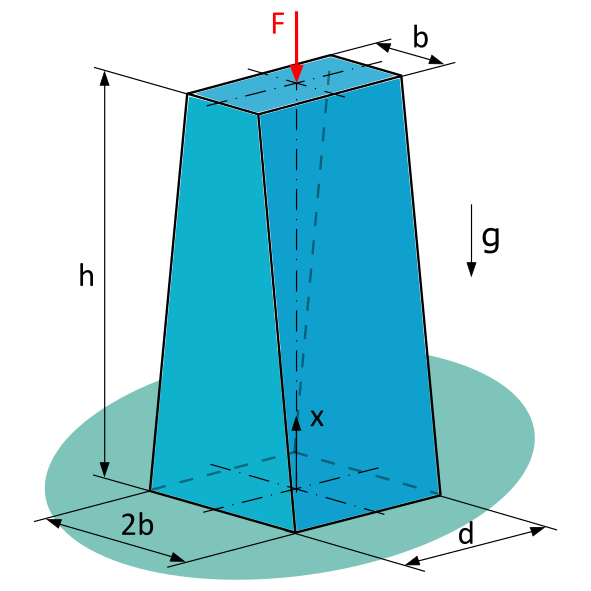
A Loaded Homogeneous Bar with Constant Thickness and Linearly Variable Width
A homogeneous bar with constant thickness \(d=20~\mathrm{mm}\) and linearly varying width is subjected to a compressive force \(F=1~\mathrm{kN}\).
Given: \(b=15~\mathrm{mm}\), \(h=80~\mathrm{mm}\), \(\varrho = 7,85~\mathrm{g/cm^3}\)
- What is the formula for calculating the cross-sectional area \(A(x)\) at any location x in a section perpendicular to the axis of the rod?
- What is the formula for calculating the normal force \(N(x)\) at any location x in a section perpendicular to the axis of the rod?
- What is the magnitude of the normal stress \(\sigma\) at the location \(x=30~\mathrm{mm}\) in a section perpendicular to the axis of the rod?
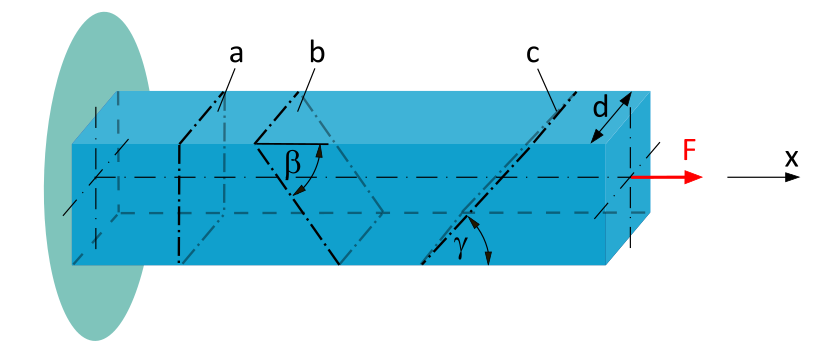
Normal and Shear Stress at an Arbitrary Section Angle
A clamped beam with a square cross-section (side length \(d=20~\mathrm{mm}\)) is subjected to a tensile force \(F=10~\mathrm{kN}\) along the beam axis.
Determine the average normal stress and the average shear stress...
- ...acting in cross-sectional plane a.
- ...acting in cross-sectional plane b (\(\beta = 50°\)).
- ...acting in cross-sectional plane c (\(\gamma = 40°\)).
Plane Stress State
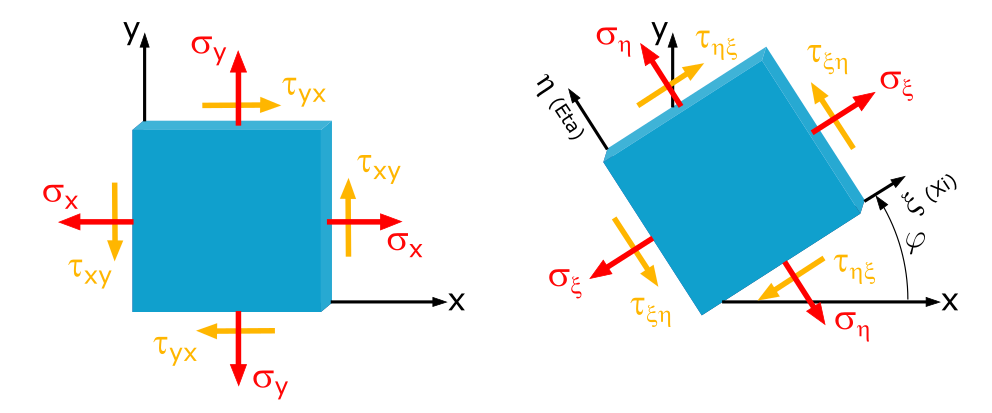
Plane Stress Transformation, x,y-Coordinates
In a sheet, the stresses \(\sigma_x = -250\mathrm{~MPa}\), \(\sigma_y = 80\mathrm{~MPa}\) and \(\tau_{xy} = 50\mathrm{~MPa}\) are given.
What normal and shear stresses occur at a section angle of \(\varphi=30°\)?
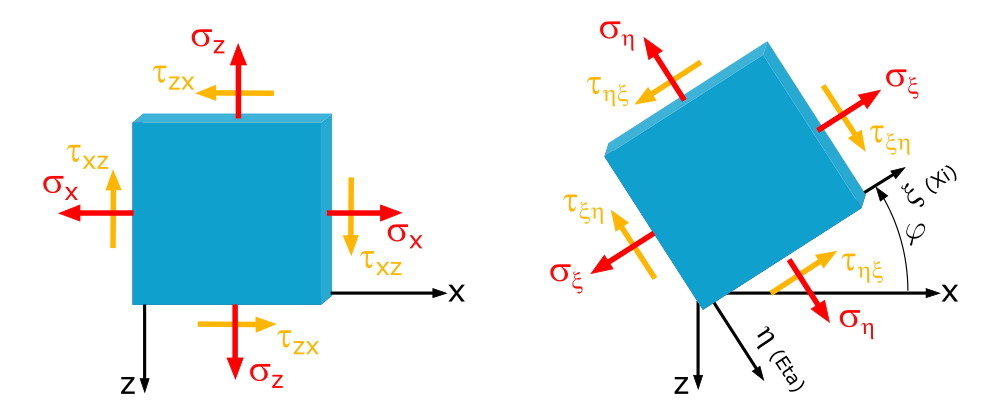
Plane Stress Transformation, x,z-Coordinates
In a sheet, the stresses \(\sigma_x = -250\mathrm{~MPa}\), \(\sigma_z = 80\mathrm{~MPa}\) and \(\tau_{xz} = 50\mathrm{~MPa}\) are given.
What normal and shear stresses occur at a section angle of \(\varphi=30°\)?
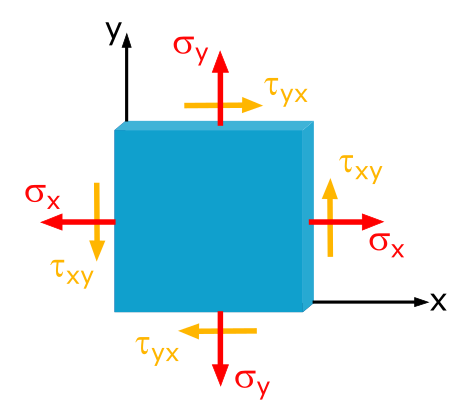
Determine the Magnitude and Direction of the Principal Stresses in the x-y Coordinate System
In a sheet, the stresses \(\sigma_x = 20\mathrm{~MPa}\), \(\sigma_y = 30\mathrm{~MPa}\) and \(\tau_{xy} = 10\mathrm{~MPa}\) are given.
Determine the magnitude and direction of the principal stresses.
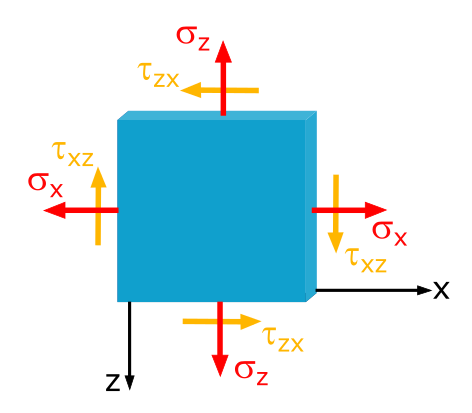
Determine the Magnitude and Direction of the Principal Stresses in the x-z Coordinate System
In a sheet, the stresses \(\sigma_x = 20\mathrm{~MPa}\), \(\sigma_z = 30\mathrm{~MPa}\) and \(\tau_{xz} = 10\mathrm{~MPa}\) are given.
Determine the magnitude and direction of the principal stresses.
Area Moment of Inertia
Area Moment of Inertia: Calculation of Arbitrarily Shaped Areas Through Integration
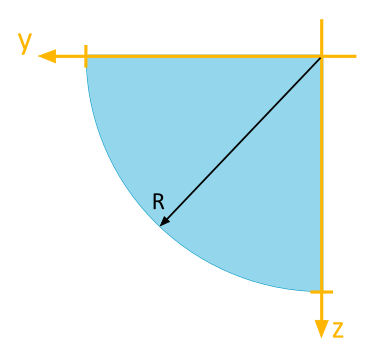
Determine the Area Moment of Inertia
For the depicted quarter-circle area, the following area moments of inertia are to be determined with respect to the illustrated \(y\), \(z\)-coordinate system:
- Axial Area Moment of Inertia \(I_y\)
- Axial Area Moment of Inertia \(I_z\)
- Biaxial Area Moment of Inertia \(I_{yz}\)
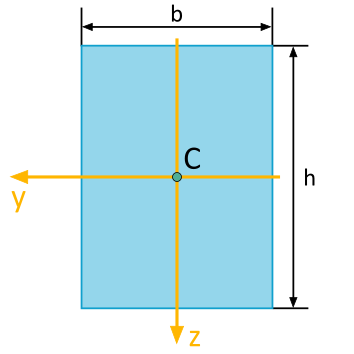
Determine the Area Moment of Inertia
For the rectangle area depicted, the following area moments of inertia are to be determined with respect to the illustrated \(y\), \(z\)-coordinate system:
- Axial Area Moment of Inertia \(I_y\)
- Axial Area Moment of Inertia \(I_z\)
- Biaxial Area Moment of Inertia \(I_{yz}\)

Determine the Area Moment of Inertia
For the triangle area depicted, the following area moments of inertia are to be determined with respect to the illustrated \(y\), \(z\)-coordinate system:
- Axial Area Moment of Inertia \(I_y\)
- Axial Area Moment of Inertia \(I_z\)
- Biaxial Area Moment of Inertia \(I_{yz}\)

Determine the Area Moment of Inertia
For the circular area depicted, the following area moments of inertia are to be determined with respect to the illustrated \(y\), \(z\)-coordinate system:
- Axial Area Moment of Inertia \(I_y\)
- Axial Area Moment of Inertia \(I_z\)
- Biaxial Area Moment of Inertia \(I_{yz}\)
Area Moment of Inertia: Parallel Displacement of Coordinate Axes - Steiner's Theorem

Determine Area Moment of Inertia for a Coordinate System Parallel to the Principal Axis System
For the depicted rectangle, the following area moments of inertia are to be determined with respect to the illustrated \(\overline{y}\), \(\overline{z}\)-coordinate system:
- Axial Area Moment of Inertia \(I_y\)
- Axial Area Moment of Inertia \(I_z\)
- Biaxial Area Moment of Inertia \(I_{yz}\)
The area moments of inertia with respect to the principal axes are given as follows:
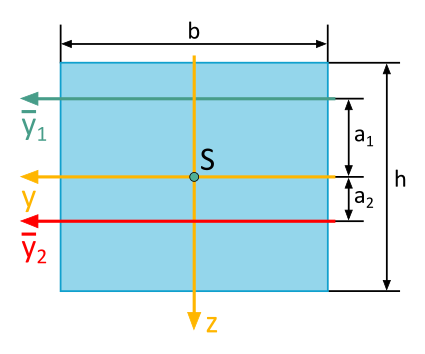
Determine Area Moment of Inertia for a Coordinate System Parallel to the Principal Axis System
The depicted rectangular cross-section has an area of \(A=72~\mathrm{cm}^2\).
The axial area moment of inertia with respect to the \(\overline{y}_1\)-axis (\(a_1 = 5~\mathrm{cm}\)) is known and is \(I_{\overline{y}_1}=2664~\mathrm{cm}^4\).
Calculate the axial area moment of inertia \(I_{\overline{y}_2}\) with respect to the \(\overline{y}_2\)-axis (\(a_2 = 2~\mathrm{cm}\)).